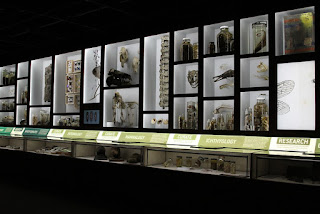Museum Pairings
Perhaps you’ve heard that our Museum Passes are back! I so enjoy talking with patrons who are participating in the program, and recently I spoke with a woman and her son as they returned from Battleship New Jersey. The son was so excited, and wanted books about Battleship New Jersey and ships in general. This is what libraries are for! Inspired by their enthusiasm and curiosity, I went hunting through the catalog and can now offer some suggested book pairings for each of the institutions that are part of our Museum Pass program.
For the pair that had just gone to Battleship New Jersey, I found USS New Jersey (BB-62): From World War II, Korea, and Vietnam to Museum Ship. This book, with hundreds of photos, documents the ship’s building, its use during three wars, and its preservation and transformation into the museum we know today.
Here is a curious one to pair with Eastern State Penitentiary: a book on silence. Silence: A Social History of One of the Least Understood Elements of Our Lives by Jane Brox tells the human story of silence through the histories of medieval monasteries and the Eastern State Penitentiary.
Onto the Elmwood Park Zoo. We have lots of books about different kinds of animals, but if you leave the zoo wondering what its like to be an elephant, I highly recommend Beyond Words: What Animals Think and Feel by Carl Safina. Ecologist and science writer Safina explores what we can know about animal minds by considering elephants, wolves, and killer whales.
For those who go to the Mercer Museum and Fonthill Castle, I will direct you to my colleague Dominic’s wonderful blog post. If you’re curious about the artistic history of the region, I suggest The Genius Belt: The Story of the Arts in Bucks County, Pennsylvania, published by the James A. Michener Art Museum with the Penn State Press, which includes a chapter about Henry Chapman Mercer and the arts and crafts movement.
As many of you will know, the Morven Museum was originally home to Richard Stockton, one of the signers of the Declaration of Independence, and later served as the governor’s mansion. My favorite part of the Morven, though, is its beautiful garden, so I suggest historian Andrea Wulf’s Founding Gardeners: The Revolutionary Generation, Nature, and the Shaping of the American Nation to learn about the founders’ relationships with gardening, agriculture, and the natural world.
Those feeling revolutionary could visit the Museum of the American Revolution. As you might imagine, we have many, many, books about all aspects of the American Revolution, but here’s a fun one: Invisible Ink: Spycraft of the American Revolution by John A. Nagy. If you’d prefer a basic overview, I’d offer The American Revolution: A Concise History by Robert J. Allison. If you go to the National Constitution Center and are considering the Constitution and your own life, maybe you’d like pair it with the play What the Constitution Means to Me by Heidi Schreck [hoopla e-book], which was a finalist for the 2019 Pulitzer Prize for Drama.
There is so much to see at the Academy of Natural Science – what’s your favorite part of the museum? The dinosaur exhibits stick out to me, so if you walk away from the museum wanting more dinos, how about The Monster's Bones: The Discovery of T. Rex and How It Shook Our World by David K. Randall.
At this point, I should also mention that, though I chose to focus on books for adults in this post, we of course have books on all these topics for young people. Now last, but not least, there’s the Bucks County Children’s Museum. If the young people in your life love the “Recycled Adventure” exhibit, you can check out Your Planet Needs You!: A Kids’ Guide to Reducing Waste and Recycling by Philip Bunting. And if they loved the hospital exhibit, I recommend The Hospital: The Inside Story by Dr. Christle Nwora.
Whether at a museum or elsewhere, if something sparks your curiosity, come talk to us at the reference desk! I didn’t want to overwhelm this post with too many book recommendations, but please know we have so many more that can complement the different offerings of each institution. Your excitement might begin at the museum but it can continue at the library!
- by Corina B., West Windsor Branch

Comments
Post a Comment